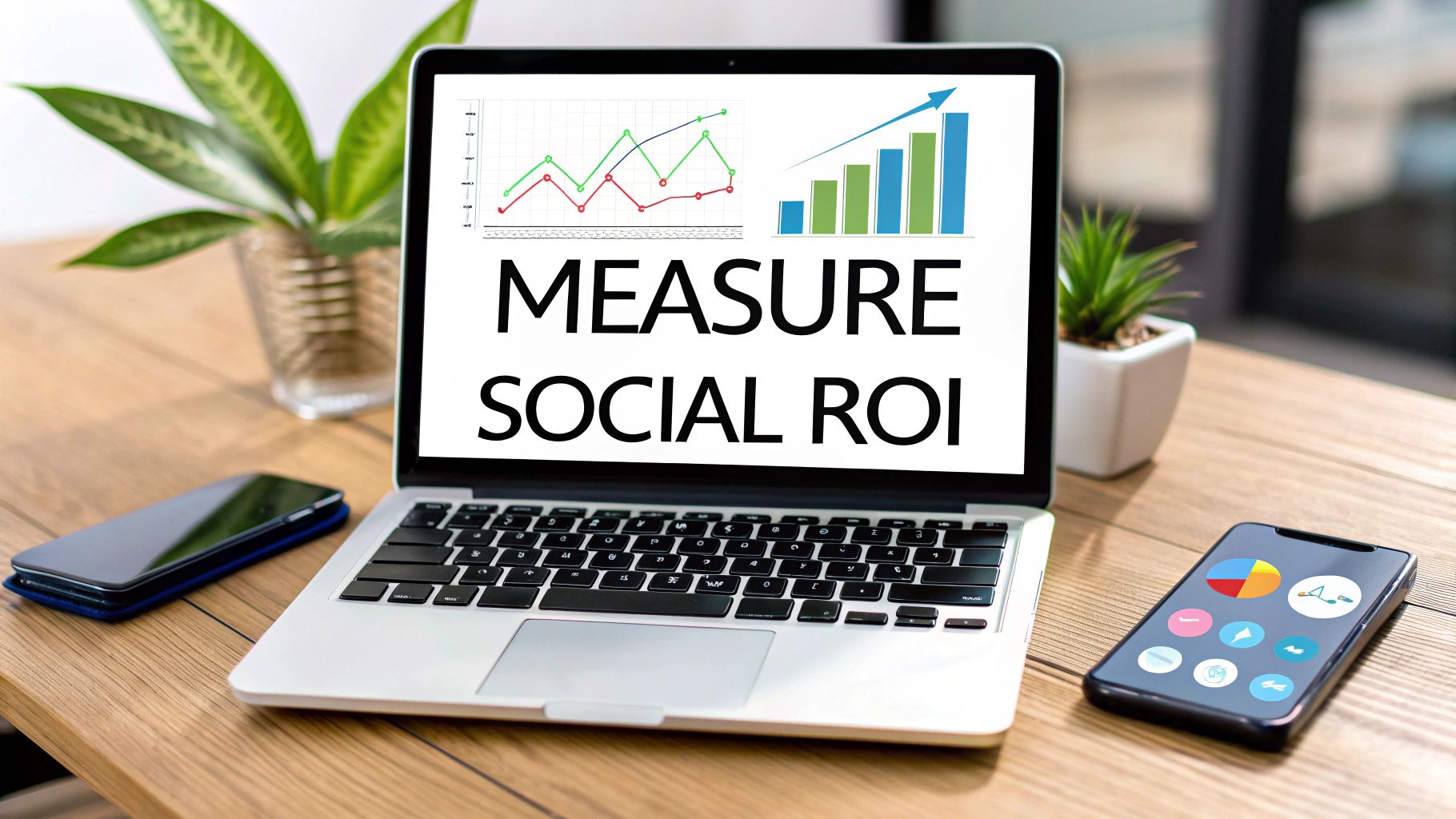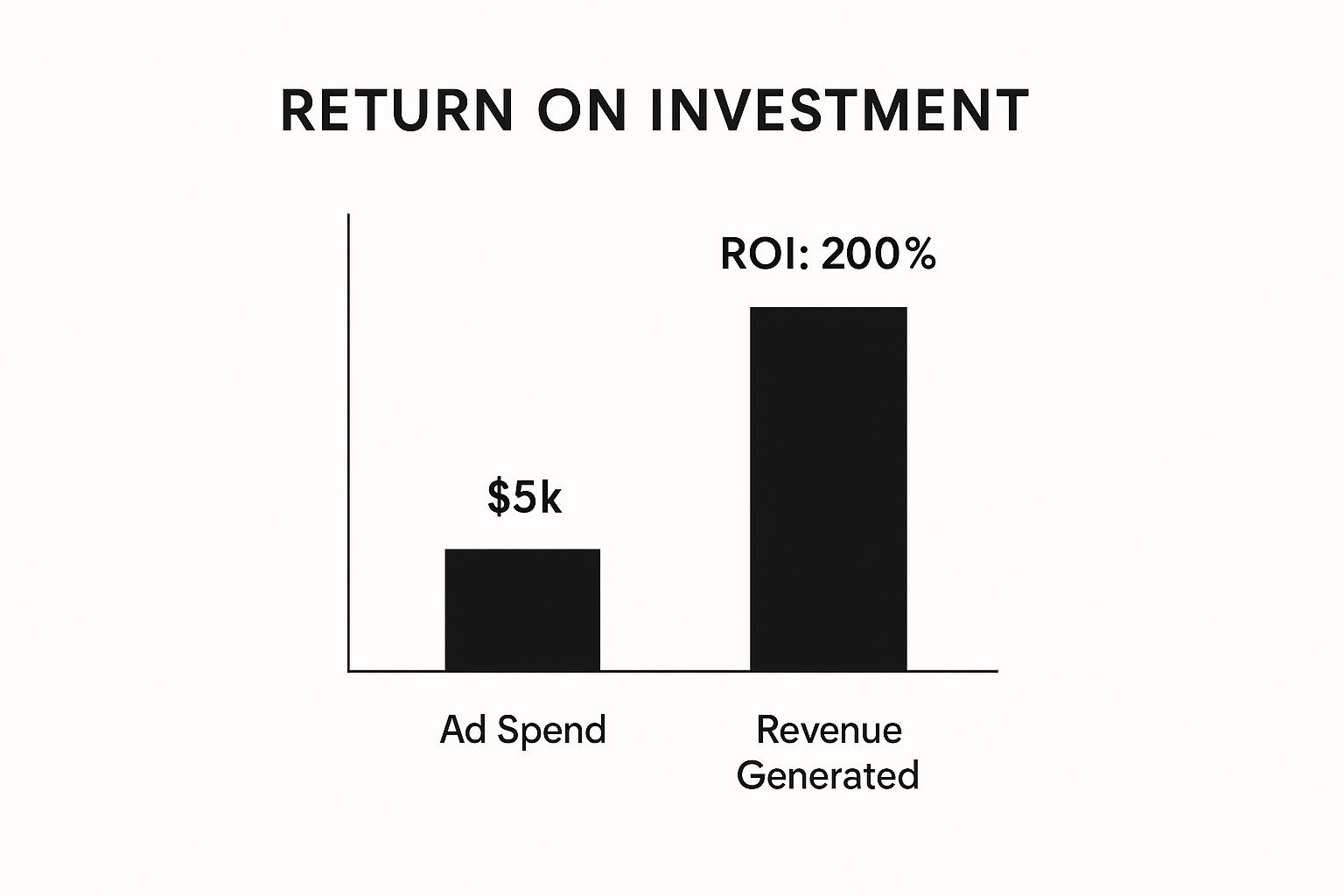
How To Measure Social Media ROI: Proven Guide for Businesses
Published on 2025-05-28
Understanding What Really Drives Social Media ROI
Many businesses fall into the trap of prioritizing vanity metrics on social media. While high engagement numbers can be exciting, they don't always translate into meaningful business outcomes. So, what really drives social media ROI? It's about understanding the difference between metrics that simply appear successful and those that genuinely impact your bottom line.
For instance, a large number of likes on a post doesn't necessarily equate to increased sales. Tracking website clicks from a social media campaign, however, offers valuable data on how effectively social media is driving traffic and potential conversions. This shift from surface-level engagement to concrete actions is key for accurately measuring ROI. Understanding the customer journey is also essential.
How does social media contribute to each stage, from initial brand awareness to the final purchase? Identifying these touchpoints helps accurately assess the role social media plays in driving conversions. Pinpointing where social media influences the buying process is critical for optimizing your strategy and maximizing your return.
Measuring Return on Ad Spend (ROAS)
Measuring return on ad spend (ROAS) is another vital factor in understanding social media ROI. ROAS measures the revenue generated for every dollar spent on social media advertising. For example, if a company spends $5,000 on social media ads and generates $10,000 in revenue directly from those ads, the ROAS is 200%. This indicates a strong return on investment.
This metric helps businesses evaluate the profitability of their social media campaigns and decide whether to scale them up or adjust their approach. Tracking engagement metrics such as likes, shares, and comments can offer insights into how well content resonates with the audience. However, these metrics alone don't necessarily translate to business gains. They need to be connected to tangible sales or lead generation goals. Learn more about measuring social media ROI effectively: Discover more insights about social media ROI. You might also find this helpful: How to master social media content planning.
Moving Beyond Vanity Metrics
How can you move beyond vanity metrics and focus on what truly matters? It starts with aligning your social media goals with your overall business objectives. Here are some key steps:
Define clear, measurable objectives: Instead of aiming for general goals like "increased brand awareness," concentrate on specific outcomes like website visits, lead generation, or sales.
Track the right metrics: Prioritize metrics directly correlated with your objectives. If your goal is to drive sales, track conversion rates and revenue generated from social media.
Analyze the customer journey: Understand how social media interacts with other marketing channels and influences purchasing decisions. Map out the customer's path to purchase and identify the role social media plays at each stage.
By adopting this strategic approach, you can uncover the true value of your social media efforts and demonstrate a clear ROI. Focusing on metrics tied to business outcomes will help you make data-driven decisions and achieve meaningful results.
Building Your ROI Measurement Foundation That Actually Works

Creating a reliable way to measure your social media ROI isn't as simple as just using analytics software. You need a comprehensive plan that aligns with your specific business goals. This framework should provide consistent and dependable data. It means establishing relevant baseline metrics, setting realistic benchmarks, and using tracking systems that capture both short-term success and long-term value creation.
Establishing Baseline Metrics and Benchmarks
First, figure out which metrics actually matter for your business. If your main goal is driving website traffic, focus on metrics like click-through rates and landing page conversions. If brand awareness is more important, then impressions and reach become more significant.
For example, tracking how social media affects website traffic shows ROI by highlighting visitors coming from social platforms. Setting realistic benchmarks is also crucial for accurate measurement.
Research industry averages and what your competitors are doing to understand typical engagement and conversion rates. This gives you context for your own performance, letting you identify areas to improve and effectively measure progress.
Implementing a Comprehensive Tracking System
The right tracking system is key for collecting and analyzing data. This involves choosing the best analytics tools, creating clear measurement processes, and ensuring everyone on your team uses them consistently.
Using UTM parameters, for example, helps you track website traffic sources and attribute conversions to specific social media campaigns. Setting up conversion funnels within your analytics platform shows how customers interact with your website and reveals areas where they might drop off.
This level of tracking helps you make informed decisions about your social media strategy and optimize campaigns for a better ROI.
Organizing Your Data and Reporting
After setting up your tracking, focus on organizing your data collection. A well-organized approach means your data is accurate, easy to find, and simple to analyze. This could mean creating standardized reporting templates or using a central dashboard to track important metrics.
For instance, compiling data into weekly or monthly reports visualizes trends and shows your progress toward your goals. This organized reporting transforms raw data into useful insights. You can then refine your social media strategy and clearly demonstrate your return on investment.
By consistently monitoring these metrics, you can see which activities are most valuable and adjust your approach as needed. This ongoing optimization ensures your social media efforts effectively contribute to your overall business goals and maximize ROI.
To help you compare different metrics, take a look at the table below:
Essential ROI Metrics Comparison
This table compares key social media ROI metrics, how they are calculated, their impact on your business, and how difficult they are to measure.
| Metric | Calculation Method | Business Impact | Measurement Difficulty |
|---|---|---|---|
| Website Traffic | Number of visitors from social media / Total website visitors | Shows how effectively social media drives traffic to your website | Easy |
| Click-Through Rate (CTR) | Number of clicks on a social media link / Number of impressions | Measures how compelling your social media content is | Easy |
| Landing Page Conversions | Number of conversions on a landing page / Number of visitors from social media | Indicates how effectively social media contributes to sales or leads | Medium |
| Impressions | Number of times your social media content is displayed | Reflects the potential reach of your social media campaigns | Easy |
| Reach | Number of unique users who see your social media content | Measures the actual audience size exposed to your message | Easy |
| Engagement Rate | (Likes + Comments + Shares) / Number of followers or impressions | Indicates how actively your audience interacts with your content | Easy |
| Conversion Rate | Number of conversions / Number of clicks on a social media link | Shows how effectively social media advertising converts to sales or leads | Medium |
The table above highlights that while basic metrics like impressions and reach are easy to track, understanding their true impact on your business requires analyzing more complex metrics like website traffic and conversion rates. Focusing on these more impactful metrics, and accurately tracking them, is the key to demonstrating the value of your social media efforts.
Tracking The Metrics That Generate Real Revenue

Stop focusing on vanity metrics. Instead, understand how to measure social media ROI by identifying metrics directly impacting your profits. This means shifting focus from likes and shares to more substantial data. This data will show how social media contributes to your business goals.
Beyond Likes and Shares: Measuring What Matters
Engagement metrics offer some insight, but they don't tell the whole story. Concentrate on metrics with a clear link to revenue. Website traffic from social media is a crucial indicator of how well your content drives potential customers to your site.
Track conversion rates too. This metric shows how many social media visitors complete desired actions on your website, like making a purchase or filling out a contact form. These actions represent real business outcomes and contribute directly to ROI.
Advanced Attribution Models for Accurate Measurement
Understanding the customer journey is key for accurate ROI measurement. Attribution models help decipher how different touchpoints, including social media, influence a customer's path to purchase.
Instead of attributing a conversion to the last click, explore multi-touch attribution models. These models credit all touchpoints, revealing the true impact of social media across the sales funnel. See the full picture of how social media works with other marketing channels to drive results.
Customer Lifetime Value (CLTV) and Long-Term ROI
For sustainable growth, focus on customer lifetime value (CLTV). CLTV measures the total revenue expected from a single customer throughout their relationship with your business.
Social media is vital for cultivating customer relationships and increasing CLTV. By nurturing leads and building brand loyalty through social media, you encourage repeat purchases. This builds long-term value and contributes significantly to overall ROI. Consider social media's influence on customer retention and repeat business.
Conversion Tracking Strategies for Clear Visibility
Implementing strong conversion tracking strategies is crucial for understanding which social media activities directly impact sales. Use tools like UTM parameters (Google Analytics) to track your website traffic sources.
This helps pinpoint which social media campaigns are driving the most valuable conversions. This detailed tracking provides clear visibility into social media performance and identifies high-performing content and strategies. You can then optimize your social media activities based on this data.
This data-driven approach ensures your efforts contribute to real business growth and maximize ROI. Through these techniques, you can transform your approach to measuring social media ROI and see significant improvements.
Maximizing ROI With Modern Content Strategies
The social media landscape is ever-evolving, and our approach to measuring Return on Investment (ROI) needs to keep pace. New content formats, such as short-form videos and interactive stories, are changing how we define and measure success. Traditional ROI methods often fall short of capturing the true impact of these formats, prompting businesses to adapt their strategies.
The Power of Short-Form Video
This shift is largely driven by changes in audience behavior. People now consume content differently, showing increased engagement with dynamic formats like Stories, live streams, and especially short-form videos. These formats offer unique engagement opportunities, often proving more immersive and shareable than static images or text posts. Understanding their performance is key to maximizing ROI.
For example, a short, engaging video demonstrating a product in action can result in higher conversion rates compared to a static product image. This underscores the importance of considering format when planning content and evaluating its success. The evolving social media ROI landscape prioritizes short-form video content.
In fact, by 2025, short-form videos like Reels, Stories, and TikToks are projected to receive three times more engagement than static images. This necessitates businesses adapting their content strategies to optimize engagement and ROI. For industries like dentistry, this means connecting engagement with tangible results, such as new patient acquisitions. Find more detailed statistics here.
Optimizing Content for Each Platform
Different social media platforms favor different content types. Instagram, for example, emphasizes visual content, while Twitter is best suited for short, text-based updates and breaking news. Optimizing your content strategy involves tailoring your approach to each platform. By analyzing engagement patterns across platforms, you can identify the type of content that resonates with each audience, allowing you to create more effective campaigns. How to master content repurposing.
Moving Beyond Vanity Metrics
While likes and shares provide a basic understanding of engagement, relying solely on these vanity metrics can be misleading. A high number of likes doesn't always translate to business outcomes. Measuring ROI requires a more comprehensive approach.
Measuring the Effectiveness of Different Formats
Measuring the effectiveness of diverse content formats is essential for strategy optimization and ROI maximization. This involves understanding Key Performance Indicators (KPIs) for each content type. For videos, this could include tracking metrics like view-through rates, watch time, and click-through rates on calls to action. For Stories, metrics like completion rate and tap-forward rate indicate engagement levels.
By analyzing these metrics, you gain insights into what's working and what's not, allowing you to adjust your content strategy accordingly. This continuous optimization ensures you're maximizing your social media investments and achieving a positive return. For instance, if Stories with interactive elements like polls or quizzes consistently have higher completion rates, this suggests that incorporating interactivity improves engagement and potentially drives conversions.

Mastering Attribution And Customer Journey Analysis
Understanding how social media contributes to your overall marketing success is crucial for demonstrating Return on Investment (ROI). This goes beyond simply looking at the last click and requires a deeper understanding of the customer journey. This section explores multi-touch attribution and customer journey analysis, providing insights into the true impact of social media on your business.
Multi-Touch Attribution: Unveiling the Full Impact
Traditional analytics often focus on the last click before a conversion, failing to acknowledge the multiple touchpoints that influence a customer's decision. Multi-touch attribution models offer a more nuanced approach. They distribute credit across various interactions, such as social media engagements, email campaigns, and website visits. This provides a more holistic view of how social media contributes to the entire sales process.
For example, imagine a customer first discovers your product through a social media post. They then visit your website several times before finally making a purchase through an email promotion. Multi-touch attribution assigns appropriate credit to each touchpoint, revealing the crucial role social media plays in initial awareness and ongoing engagement.

The infographic above illustrates a simplified ROI calculation. A $5,000 ad spend generated $15,000 in revenue, resulting in a 200% ROI. This example highlights the direct link between investment and return, underscoring the need for accurate tracking of revenue generated by social media activities. By carefully monitoring ad spend and correlating it with revenue, you can effectively demonstrate the value of your social media campaigns.
Mapping the Customer Journey: From Interaction to Conversion
Mapping the customer journey involves tracking customer interactions from their initial touchpoint on social media all the way through to conversion and beyond. This process allows businesses to pinpoint the most effective touchpoints. This knowledge enables optimized marketing strategies and improved customer experiences. Tools like Google Analytics help track website traffic sources and understand how social media contributes to conversions. Additionally, Customer Relationship Management (CRM) systems capture customer interactions across various touchpoints, offering a complete view of the customer journey.
Let's look at a comparison of a few popular attribution models to better understand their strengths and weaknesses:
Attribution Models Performance Data: Statistical comparison of different attribution models and their effectiveness in measuring social media ROI.
| Attribution Model | Accuracy Rate | Implementation Complexity | Best Use Case |
|---|---|---|---|
| Last Click | Low | Low | Measuring direct response campaigns |
| First Click | Low | Low | Identifying initial touchpoints |
| Linear | Medium | Medium | Understanding overall contribution of each touchpoint |
| Time Decay | Medium | Medium | Emphasizing touchpoints closer to conversion |
| Position Based | High | High | Valuing both first and last touchpoints while acknowledging middle interactions |
This table summarizes the different characteristics of common attribution models. As you can see, choosing the right model depends on your specific needs and resources. While Last Click is simple to implement, Position Based models often provide a more accurate representation of the customer journey.
Measuring Assisted Conversions: Uncovering Hidden Value
Traditional analytics often overlooks assisted conversions, where social media plays a supporting role in driving sales. For example, a customer might click on a social media ad but not make a purchase immediately. They might return later through a different channel and complete the conversion. Tracking assisted conversions reveals the indirect influence of social media, even if it wasn't the final touchpoint. By implementing proper tracking, you can uncover this hidden value and gain a more accurate understanding of social media's true contribution to your bottom line. This approach emphasizes how social media builds brand awareness and nurtures leads, especially in longer, more complex sales cycles. Mastering attribution and customer journey analysis allows businesses to fully understand the value of their social media investment, pinpointing the most influential touchpoints in the conversion process.
Choosing The Right Tools For Accurate ROI Tracking
Accurately tracking your social media ROI requires having the right tools. With so many options available, choosing the right tools can feel a little overwhelming. This section will guide you toward selecting the best mix of platform-native analytics, third-party tools, and integrated solutions to give you a clear understanding of your social media performance.
Platform-Native Analytics: Your Starting Point
Most social media platforms provide built-in analytics dashboards. These dashboards typically offer basic information on engagement, reach, and audience demographics. For instance, Facebook Insights provides details on post reach, likes, and shares. Meanwhile, Twitter Analytics tracks impressions, retweets, and profile visits. These platform-specific tools are a good starting point for understanding your basic performance. However, they may not be enough for comprehensive ROI measurement.
Third-Party Tools: Deeper Insights
Third-party tools offer more advanced metrics and reporting than platform-native analytics. Tools like SproutSocial and Hootsuite include features such as competitor analysis, keyword tracking, and customizable reporting dashboards. These tools can give you a broader view of your performance, offering insights not available in native tools. This lets you compare your performance against competitors and spot areas for improvement.
Integrated Solutions: Connecting the Pieces
Integrated solutions are vital for getting a complete view of your ROI. These tools link your social media data with other marketing platforms, such as your CRM or Google Analytics. This connection allows you to track the entire customer journey, from their first interaction on social media to a final purchase.
For example, integrating social media data with your CRM shows which leads originated from social media and how they converted into customers. This clearly demonstrates how social media contributes to your overall business goals, highlighting its true ROI. You might be interested in: How to monetize LinkedIn.
Google Analytics: Measuring Social Media Traffic
Google Analytics is a valuable free tool for tracking website traffic from social media. By using UTM parameters, you can tag your social media links and see precisely which platforms and campaigns are bringing visitors to your site. This detailed tracking helps pinpoint which content resonates best with your audience so you can refine your strategy and optimize for higher conversions. You can even set up specific goals, such as newsletter sign-ups or purchases, and see how social media contributes to these conversions.
Integrating Data For a Clear ROI Picture
Combining data from multiple sources is the key to accurately measuring social media ROI. By integrating data from platform-native analytics, third-party tools, and Google Analytics, you can create a comprehensive picture of social media’s impact on your business. This goes beyond simple vanity metrics and emphasizes key data such as website conversions and lead generation. This allows for more informed decisions about your social media strategy and demonstrates its real business value.
Evaluating New Tools and Technologies
The social media world is always changing, with new tools and technologies emerging regularly. It's important to evaluate new solutions effectively to stay competitive. When considering a new tool, pay attention to its integration capabilities, data visualization options, and reporting features. The tool should align with your specific business needs and provide actionable insights to improve your ROI. By carefully assessing and strategically integrating new solutions, you can optimize your social media tracking and accurately measure its true impact.
Key Takeaways
This section offers a practical guide to measuring your social media ROI, using proven strategies and real-world examples. It provides actionable steps you can implement immediately, along with methods for tracking progress. We'll also explore potential challenges, how to maintain momentum, and setting benchmarks for success.
Focusing on the Right Metrics
The first key takeaway is focusing on the right metrics. Many businesses focus on vanity metrics like likes and shares. True ROI measurement, however, connects social media activity to tangible business results. Track metrics like website traffic from social media, conversion rates, and lead generation. These directly show how social media contributes to your bottom line.
For example, if a campaign generates a 10% increase in website traffic from social media, and that traffic leads to a 5% rise in sales, you’ve established a clear connection between social media and revenue.
Building a Solid Measurement Foundation
A solid measurement foundation is crucial for long-term success. This means establishing clear goals, defining key performance indicators (KPIs), and choosing the right analytics tools. Your goals should be specific and measurable, your KPIs aligned with your business objectives, and your tools capable of delivering the data you need. This foundation will enable accurate data collection and progress tracking toward your goals.
Understanding the Customer Journey
Social media rarely operates in a vacuum. It influences the broader customer journey, impacting decisions at various touchpoints. Using multi-touch attribution models is therefore essential. These models consider the influence of multiple marketing channels, providing a more complete picture of how social media contributes to conversions.
For example, a customer might discover your product through a social media post, then return later via a search engine ad before finally purchasing. Multi-touch attribution recognizes social media's role in that initial awareness stage.
Leveraging Modern Content Strategies
Modern content strategies can significantly improve your ROI. Experiment with various content formats, especially short-form video, which has seen a surge in popularity. Remember that different platforms favor different types of content. Analyzing engagement patterns and performance characteristics across platforms allows you to optimize your strategy for maximum impact. This data-driven approach ensures your content aligns with audience preferences.
Consistent Monitoring and Optimization
Finally, remember that social media ROI isn't a one-time effort. Consistent monitoring and optimization are vital. Regularly review your data, identify trends, and pinpoint areas for improvement. Staying informed about changes in platform algorithms and adapting your strategy accordingly is also crucial. This continuous process ensures your approach remains effective and maximizes your return on investment.
Ready to improve your LinkedIn content and boost your social media ROI? autoghostwriter can help. With AI-powered content creation, you can easily create engaging posts that drive results. Check out our various subscription plans: Get started with autoghostwriter today!